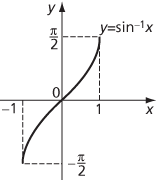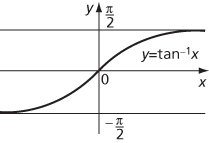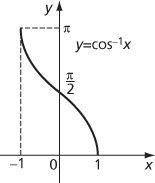Sine is not a one-to-one function, and so not invertible, but ‘inverse sine’ can be defined by choosing a set of principal values. Thus, if y = sin−1 x, then x = sin y, but the converse need not hold. For each x in the interval [−1,1] there is a unique y in the interval [−π/2, π/2] such that x = sin y and this value of y is defined as y = sin−1 x.
Similarly, for real x, y = tan−1 x if x = tan y, and the unique value y is taken from the interval (−π/2, π/2). Also, for x in the interval [−1,1], y = cos−1 x if x = cos y and the unique value y is taken from the interval [0, π].
The notation arcsin, arctan, and arccos for sin−1, tan−1, and cos−1 is also used. Their derivatives are:

Graph of inverse sine

Graph of inverse tangent

Graph of inverse cosine
- double pulsar
- double quasar
- double recessive
- double refraction
- double root
- double salt
- double sampling
- double sequence
- double series
- double sideband
- double sideband suppressed carrier
- double-sideband transmission
- double-slit experiment
- Double Star
- double star
- Double Star (mission)
- double sulphides
- doublet
- double tangent(bitangent)
- double taxation
- double taxation agreement
- double transposition cipher
- double truth
- double turnstile
- double zig-zag